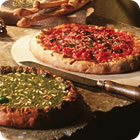
There's almost no limit to the toppings that can be placed on a pizza crust.

1. Generally, the hotter the oven, the better the pizza will be.
Place a pizza stone on a lower oven rack. Preheat the oven between 450 and 500 degrees F (250 to 260 degrees C)--the stone needs heat up while the oven heats. Large thick-crusted pizzas might need the oven's temperature to be closer to 400 degrees F (200 degrees C) in order to cook completely before the toppings burn.
A great way to create a crunchy crust is to preheat a baking sheet or cast iron skillet in the bottom of the oven. Once you load the pizza, toss ice cubes into the hot pan to create a burst of steam.
Place a pizza stone on a lower oven rack. Preheat the oven between 450 and 500 degrees F (250 to 260 degrees C)--the stone needs heat up while the oven heats. Large thick-crusted pizzas might need the oven's temperature to be closer to 400 degrees F (200 degrees C) in order to cook completely before the toppings burn.
A great way to create a crunchy crust is to preheat a baking sheet or cast iron skillet in the bottom of the oven. Once you load the pizza, toss ice cubes into the hot pan to create a burst of steam.

2. Once the pizza dough has been formed and placed on a dusted peel, lightly brush the crust with olive oil. This helps ensure a golden brown, crispy crust rather than a dry, dusty outer crust. However, oil is not required; for a lower-fat pizza, skip the oil altogether.

3. We topped our crust with tomatoes and fresh basil, followed with a thin layer of cheese.
There is an infinite amount of creativity that can go into this fun process. Pizza can be made with exotic topping like apples and walnuts or fresh figs and prosciutto just as easily as traditional tomato sauce and pepperoni. In Europe and Japan, common pizza toppings include sweet corn and peas.
There is an infinite amount of creativity that can go into this fun process. Pizza can be made with exotic topping like apples and walnuts or fresh figs and prosciutto just as easily as traditional tomato sauce and pepperoni. In Europe and Japan, common pizza toppings include sweet corn and peas.

4. The order in which the ingredients are layered is important: the same ingredients layered in a different order will yield a completely different product. If we had put the cheese down first, the tomatoes, then the basil, the basil would burn and the cheese would not brown.
We chose Mozzarella, Fontina and Parmesan cheeses to top our pizza. These cheeses are all very low in moisture and will brown fairly quickly. The tomatoes, however, have a high moisture content and will not caramelize, but will dehydrate slightly for a more concentrated tomato flavor. With the cheese on the top, the basil will not burn, and the tomatoes will retain most of their moisture.
We chose Mozzarella, Fontina and Parmesan cheeses to top our pizza. These cheeses are all very low in moisture and will brown fairly quickly. The tomatoes, however, have a high moisture content and will not caramelize, but will dehydrate slightly for a more concentrated tomato flavor. With the cheese on the top, the basil will not burn, and the tomatoes will retain most of their moisture.

5. Once the oven is hot and the pizza is topped and ready to go, it is time to place the pizza on the hot pizza stone. Before placing the pizza in the oven, jiggle the peel. Make sure the pizza slides around easily and does not stick to the peel. If it is stuck at all, gently lift the sticky dough and dust with more flour or cornmeal.

6. Place the tip of the peel on the edge of the stone at the back of the oven. With one swift motion, jerk the peel back out from under the pizza. If the pizza sticks to the peel, all of the toppings will slide off the pizza onto the stone. If the pizza slides freely on the peel, it should land perfectly in the middle of the pizza stone. Close the oven door and let the pizza bake.

7. Depending on your oven and the size of the pizza, it might need to be turned to ensure even baking. Check the pizza after the first five minutes in the oven. If some areas are browning more than others, slip the peel underneath the pizza like a giant spatula. Rotate the pizza on the peel and return it to the baking stone using the same swift motion described above.

8. If you like, remove the pizza from the oven halfway during baking to brush more oil on the crust. This added oil will help the crust darken and make it even tastier. To add a garlic flavor, infuse the oil with minced garlic before brushing it onto the crust.

9. The pizza is done when the cheese is melted and medium to dark brown in color--color is flavor. Carefully remove the pizza with the peel and let it cool slightly.

10. It can be topped with additional fresh basil if desired. Slice with a pizza wheel or chef's knife, and serve.



0 komentar:
Post a Comment